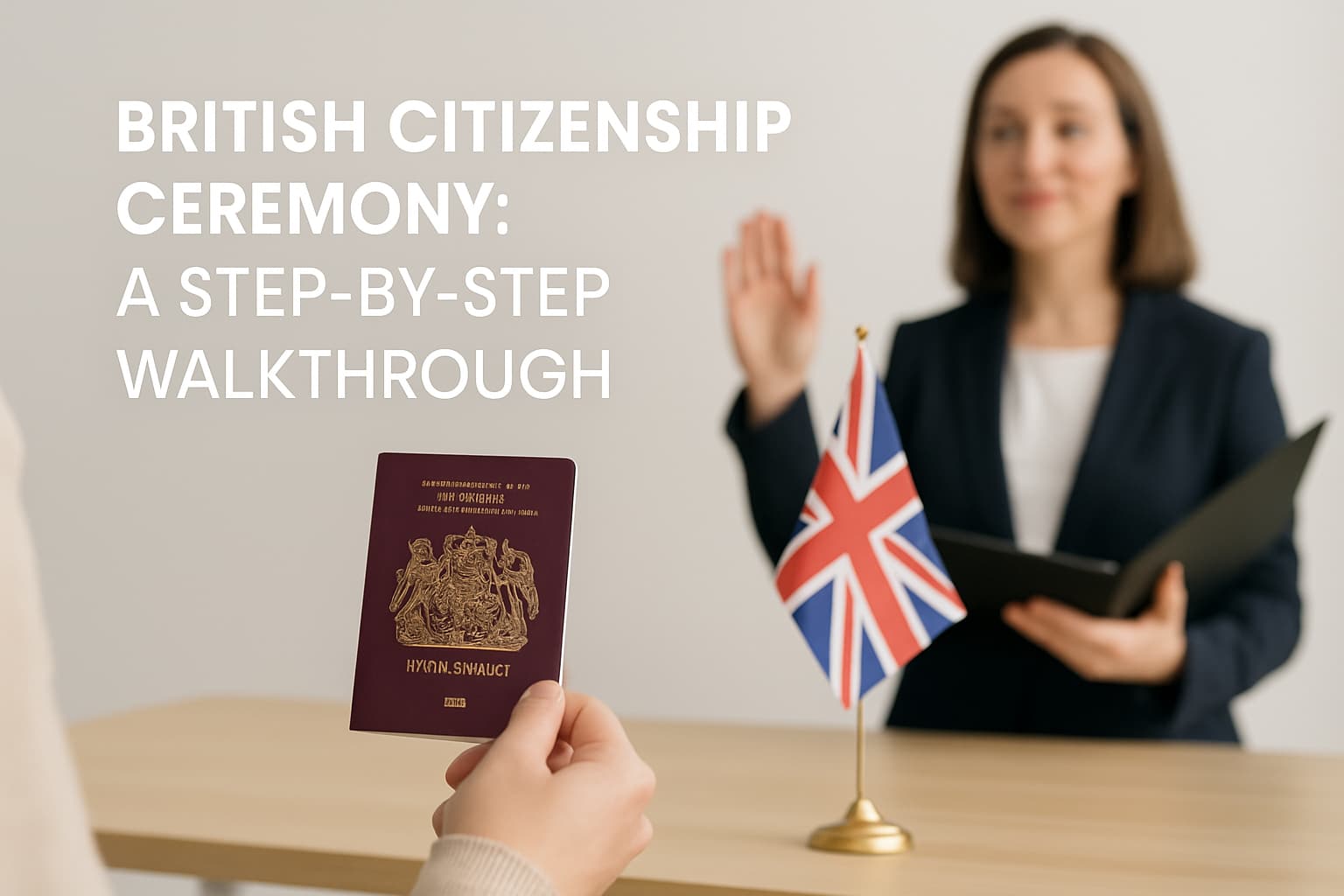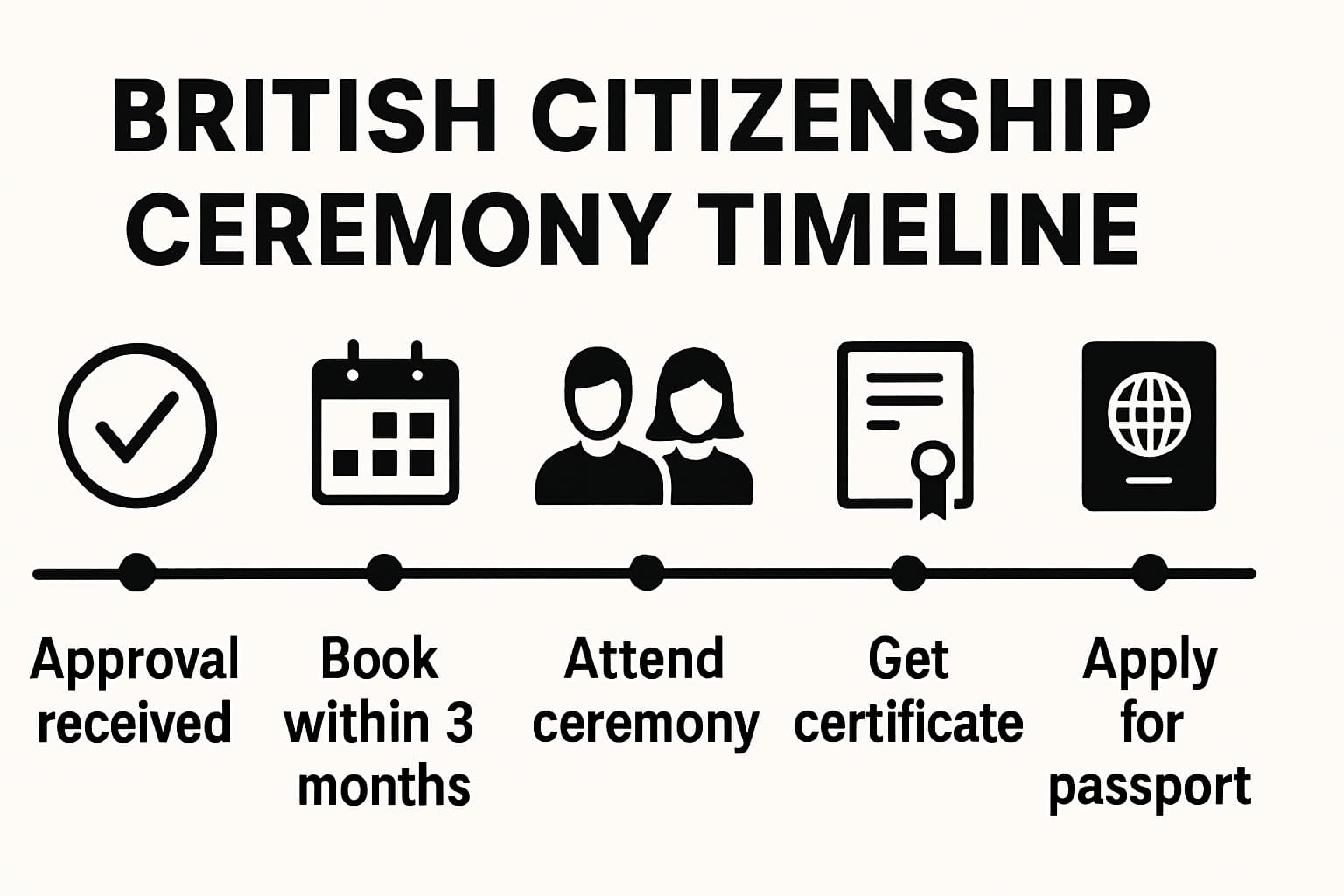British Citizenship Ceremony: A Step-by-Step Walkthrough

Your Home Office approval has arrived—congratulations. The British citizenship ceremony is your final, celebratory step to becoming a UK citizen. This guide walks you through booking, what happens on the day (oath, pledge, certificate), and the post-ceremony to-dos so you feel prepared and confident.
We will cover the purpose and timing, how to choose between group and private ceremonies, what to bring, a minute-by-minute timeline, aftercare (passport, BRP, records), a printable-style checklist, and FAQs.
Overview: Why the British Citizenship Ceremony Matters
The British citizenship ceremony is a formal welcome into the UK community. It comes after your naturalisation application is approved by the Home Office and is a legal requirement for adults to complete naturalisation.
Purpose of ceremony: To make the oath or affirmation and pledge, formally confirming your commitment to the UK, and to receive your certificate of British citizenship.
Who must attend: If you are 18 or over and your application is approved, you must attend a ceremony.
Where it fits in the timeline: Most applicants receive a decision within about six months, then book a ceremony with their local council after the invitation arrives (Home Office guidance).
Deadline to attend: You must book and attend within roughly three months of your invitation. Some routes specify 90 days, or your application can be refused if there is no good reason for delay. Always follow the deadline stated on your invitation.

New citizens are welcomed at council venues across the UK; for example, some councils celebrate thousands of new citizens over time, reflecting the scale of these events in local communities.
New to the process? See our complete overview: How to Get British Citizenship: The Complete Guide.
Booking Your Ceremony: Timeline and Choices
After approval, you will receive an invitation with instructions to book at your local council. Typically, you must attend within three months of the invite; some routes specify a 90-day deadline.
Wait for the invitation from the Home Office or your council.
Book promptly: many councils offer online booking and multiple dates.
Choose group or private (availability varies by council).
Note guest limits and any fees for private ceremonies.
Official guidance: citizenship ceremonies. Deadline example: attend within 90 days or risk refusal if you do not have good reason.
Group vs Private Ceremonies: Which Is Right for You?
Most councils run regular public group ceremonies and offer private options for an additional fee. The experience is similar; the main differences are size, pace, cost and guest numbers.
Option | Typical duration | Guests | Typical extra fee | Good for |
|---|---|---|---|---|
Group (public) | About 1 hour (allow up to 1.5–2 hours from arrival) | Often 2 guests | Usually included | Shared celebration, standard option |
Private | About 20–30 minutes | 3–5 guests commonly | Varies by council | Speed, flexibility, quieter setting |
Examples (check your council for the latest):
Royal Borough of Kensington and Chelsea: public group about 1 hour; private about 25 minutes; private additional fee £239; guests: 2 for public, 3 for private.
Camden: allow up to 2 hours from arrival; private ceremonies £165 each adult; public ceremonies typically mid-week.
Southampton: private ceremonies £135 Mon–Fri or £150 Sat; up to five guests for private.
Nottinghamshire: group ceremony guide suggests allow around 1.5 hours.
Documents to Bring and How to Prepare
Photo ID: passport or driving licence.
Invitation details: your ceremony invite and any reference numbers.
Home Office approval letter or email, if requested.
BRP (if instructed): bring or retain as your council directs; follow their guidance on handling or return.
Practical tips:
Arrival time: be 15–30 minutes early for registration and ID checks.
Dress code: smart or smart-casual is typical; wear what feels respectful and comfortable.
Guests and accessibility: confirm guest limits, step-free access, seating and language support when booking.
Pronunciation: note the oath wording beforehand so you can speak clearly and confidently.
What Happens at a Citizenship Ceremony: The Timeline
Here is a typical flow. Councils vary slightly, but the key elements are consistent.
Arrival and registration: check in, show ID, receive seating guidance.
Welcome by registrar or civic host: housekeeping, schedule overview.
Oath or affirmation: you choose to swear by God (oath) or make a non-religious affirmation, usually said together as a group.
Pledge of loyalty: pledge to respect the UK’s rights, freedoms and laws.
Certificate presentation: your naturalisation certificate is presented; photo moments often follow.
Closing: some venues play the National Anthem and offer brief remarks before departure.
Arrival, Registration and Seating
Expect an ID check and a quick confirmation of your details. Staff will direct you to seats and explain the order of events and any local etiquette. Allow extra time—some councils advise up to two hours from arrival, while others suggest around 1.5 hours.
The Citizenship Oath or Affirmation
Definition: The citizenship oath or affirmation is your formal promise of allegiance to the King and the United Kingdom. You can either swear an oath to God or make a non-religious affirmation. Both are equally valid under UK law (official guidance).
Choosing your form: You can indicate your choice when booking or at arrival.
Format: The superintendent registrar typically leads the wording; you speak in unison with others.
Tip: Speak slowly and clearly—no need to memorise; you will be led through the text.
The Pledge of Loyalty and National Anthem
After the oath or affirmation, you make a pledge to respect the rights, freedoms and laws of the UK (Home Office). Many councils conclude with the playing of the National Anthem; standing respectfully is customary, and singing is optional (example council guidance).
Certificate Presentation, Photos and Closing
At the end, you are presented with your certificate of British citizenship and often a welcome pack (official guidance). Many venues offer time for photos with local dignitaries or signage. Staff will share any final instructions and how to contact the council for copies or corrections if needed.
After the Ceremony: Next Steps and Legal To-Dos
Once you have your certificate, you can begin updating documents and records. Use this quick plan in the first 1–2 weeks:
Apply for your first British passport (see section below).
Follow official instructions for your BRP (if you had one) and any returns or updates.
Update right to work/rent status with your employer or landlord if requested.
Update banks and financial providers to keep KYC records accurate.
Update your GP and NHS records if your immigration status is recorded.
Check HMRC and DVLA details as needed.
Register to vote or update your electoral records.
Passport Application and BRP Return
After naturalisation, many people apply for their first UK passport straight away. For a step-by-step, see our guide: Applying for British Passport: Post-Ceremony Checklist.
If you held a biometric residence permit, follow the exact instructions provided by the Home Office or given at your ceremony. For background on BRP rights and practicalities, read: Your biometric residence permit: work, rent, travel rights.
Planning travel? Avoid booking non-refundable trips until your passport timeline is clear.
Update Employers, Banks and Voter Registration
Employers: share new status if asked for right to work verification.
Landlords/agents: confirm right to rent if requested.
Banks and fintechs: update KYC with your British citizenship if relevant to your profile.
GP/NHS, HMRC, DVLA: keep personal records consistent.
Electoral register: register or update details to vote in UK elections.
Looking ahead from visas to citizenship? Explore our UK Immigration Roadmap for the big-picture journey.
Ceremony Day Checklist
Print or save this list to stay calm and organised.
[ ] Photo ID (passport or driving licence)
[ ] Ceremony invitation and booking confirmation
[ ] Home Office approval letter or email (if requested)
[ ] Any BRP instructions from your council or the Home Office
[ ] Arrive 15–30 minutes early for registration
[ ] Smart or smart-casual outfit
[ ] Confirmed guest names and accessibility needs
[ ] Phone charged for photos (check venue rules)
FAQs
How long is the ceremony?
Public group ceremonies are often around 1 hour; private ceremonies can be about 25–30 minutes. Allow 1.5–2 hours from arrival as some councils advise.
Can I bring guests?
Many councils allow two guests for group ceremonies and more for private (for example, three or up to five). Check your council’s limits on your invite.
Do I have to sing the National Anthem?
No. Standing respectfully is customary; singing is optional in most venues.
What if I am late?
Call the venue immediately. If you miss your slot, you may need to rebook within your invitation’s deadline.
Is there a Welsh language option?
Some councils in Wales offer bilingual elements. Ask your local office when booking.
Not There Yet? Ace the Life in the UK Test
If you are still preparing for naturalisation, the Life in the UK Test is a mandatory step. The Life in the UK Test App helps you pass first time without overwhelm.
All official handbook content optimised for mobile study.
Brit-Bear smart assistant guides your study plan and fills knowledge gaps.
Readiness score so you know exactly when you are exam-ready.
650+ practice questions with clear explanations and realistic mock tests, including Hard Mode.
Offline access to study anywhere, anytime.
Thousands of learners use structured mock tests and spaced review to build confidence and avoid costly retests. Start smarter today:
Download on App Store | Get it on Google Play
Already approved? Keep this article handy for the day. Preparing now? Read our method: Prepare for Life in the UK Test: Expert Method for First-Time Pass.
Quick CTA: Be Ceremony-Ready Sooner
Beat stress and reach your ceremony faster with focused study. Try the Life in the UK Test App now: App Store | Google Play.
Summary
The British citizenship ceremony is a positive, structured event: book within your deadline, bring ID and your invitation, choose oath or affirmation, make the pledge, receive your certificate, and begin your post-ceremony updates. With this walkthrough, you are ready for a smooth and memorable day—and a confident start as a British citizen.